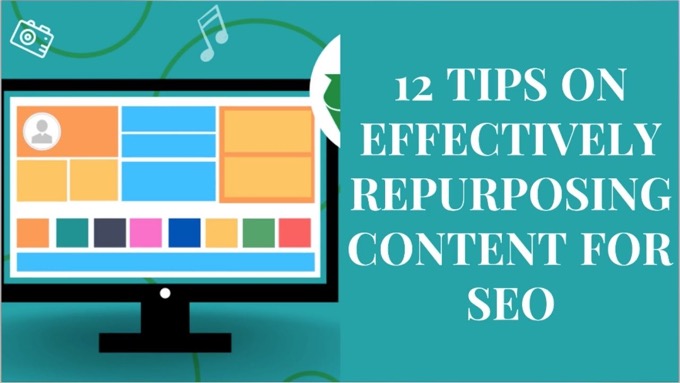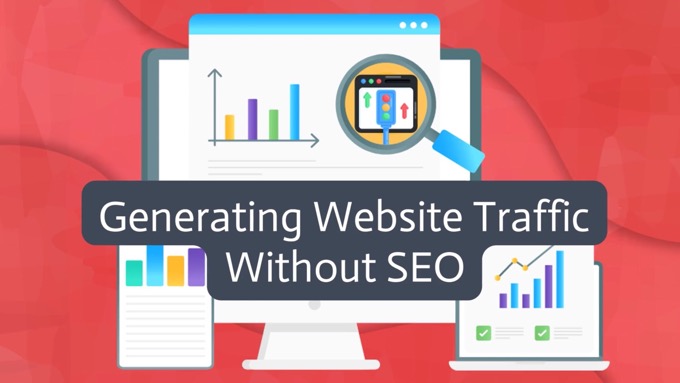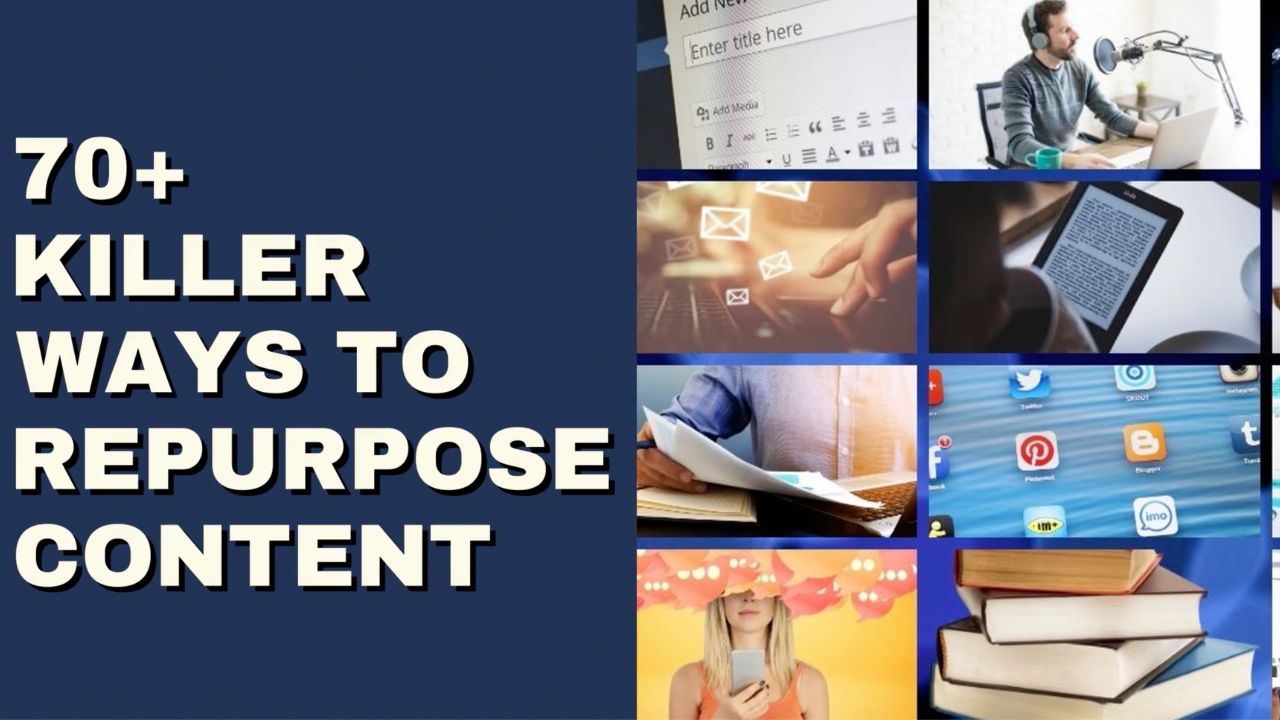- Nine out of ten marketers find repurposing content more effective than creating and publishing brand new content.
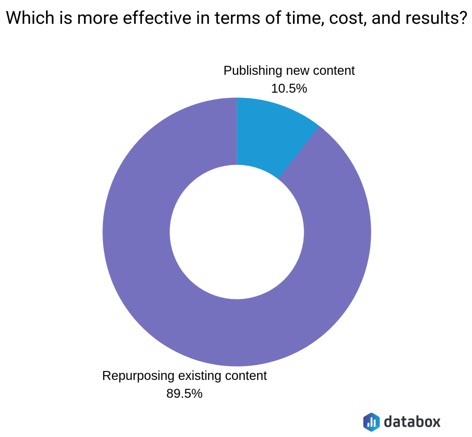
That includes SEO, with repurposed content helping you to:
- Rank higher in search
- Achieve more search visibility such as through additional listings
- Attract more search engine traffic back to your website.
So how should you approach it?
Let's find out —here are 12 tips for effectively repurposing content for SEO. Look for two or three that resonate, and start incorporating them into your content marketing workflow...
1. Repurpose onto Different Platforms
By repurposing content onto different platforms, you quickly multiply the amount of content you have on the search engines for your target keywords.
Here's an example of how that works.
Let’s say you run a membership site related to dog ownership, and write a blog post related to the keyword, train a puppy to lie down.
You then repurpose that same post (see 4. below) for Medium.
You then create a video based on the post for YouTube.
Doing so means that anyone searching Google for keywords related to train a puppy to lie down has many more chances of finding your content.
Your content on your blog, on Medium and even on YouTube could potentially even be listed for the same search query on the same page.
We use a different keyword here for the example, but that might start to look something like the following: 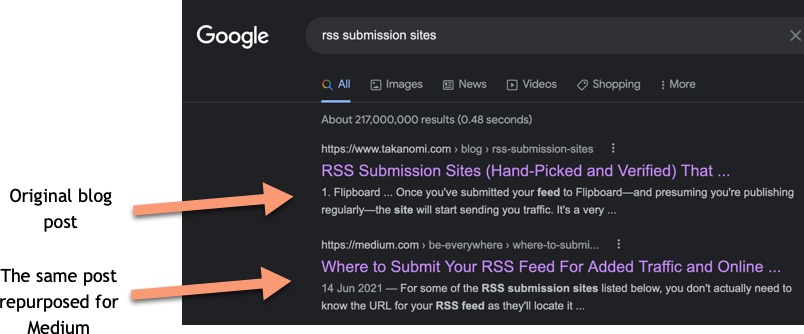
This is how you start to dominate your niche—and it’s far more efficient to repurpose existing content than create brand new content.
Remember too that the benefits aren’t solely restricted to just Google Search.
Content platforms have their own search functionality too that get a lot of usage - like YouTube, Quora, Medium, LinkedIn and so on.
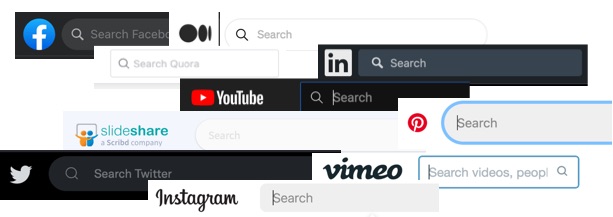
Repurposing onto multiple platforms means your content shows up on these other search engines too, putting you in front of brand new audiences.
Attention Entrepreneurs, Business Owners and Marketers
How to Transform Your Blog Into a "Be Everywhere" Marketing Engine That Promotes Your Business Across the Web (Almost on Auto-Pilot!)
Join Us Wednesday @ 2pm EDT For This FREE Live "Be Everywhere" Training — Register Your Spot Now:
2. Link Back from Repurposed Content
Where possible, link back from repurposed content to your blog content.
This is at the bottom of one of our repurposed Medium posts, linking straight back to this blog: 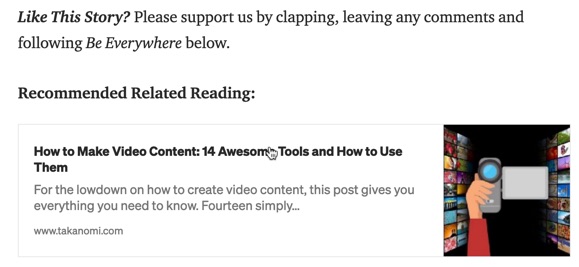
Doing so won’t always give you direct SEO benefits, but people clicking through to your blog can help you indirectly, such as when they:
- Share your blog’s content or follow you on social, helping to boost social signals for SEO
- Sign up to your newsletter and from there, connect with you on social or click through on your content in the SERPs, thanks to the relationship they have with you (another positive SEO signal)
- Add a comment to your blog
3. Embed YouTube Videos Back Into Your Blog
If you’re repurposing blog posts as YouTube videos, embed them back into your blog.
We’ve started doing that here, you’ll see an example further down this post.
It not only helps those videos attract viewers, and helps your channel attract subscribers, it also:
- Adds to the value you provide to visitors (essential for good SEO)
- Builds your relationship with visitors
- Keeps them on your blog for longer, one factor that can increase rankings and search engine traffic.
4. For SEO Benefits, Don’t Just Copy-and-Paste Verbatim
When repurposing blog content for SEO purposes onto long-text content platforms like Medium and Quora, don’t just copy and paste your blog post word for word.
Doing so can damage rather than enhance your search rankings.
Avoid copying and pasting blog posts onto other content platforms verbatim. Instead, repurpose each post as a new version. It's far better for SEO.Click To Post OnHow Can a Quick Copy-and-Paste Damage Your SEO?
While you can point back to your original blog post from the repurposed content, and hope that Google recognizes it as the original, it’s not guaranteed to do so.
If you repurpose a post for Medium, Google may at some point:
- See that post as more authoritative
- Drop your own blog’s listing from search.
So What Should You Do?
Rework the post when publishing it elsewhere. That means changing the title, rewording it, moving things around (easy with listicles).
Yes, I know, I know. That takes longer. But not that much.
And...
- It’s a lot quicker than writing a brand new post from scratch.
- It can be easily outsourced or otherwise delegated.
- It’s well worth it, because now not only do you keep your own blog’s content unique, you also end up with more than one listing in search, multiplying the traffic your content can now attract.
The same reworked post can also be posted on multiple platforms.
So rework it for Medium, but then publish it too on say LinkedIn Articles and Quora Spaces.
5. Repurpose Content as Guest Posts
We’ve covered guest blogging for SEO before, here’s a quick summary of how to get started:
When guest blogging, rather than start a brand new post from scratch, repurpose an existing post on your own blog.
It needs to be unique, so that means rewriting it to suit the blog in queestion, but doing so is a lot less work than creating a brand new post.
How Does This Help SEO?
In return for your guest post, you’ll nearly always get one or more links back to your website.
And as you’ll often be posting on more authoritative blogs, that helps transfer some of their authority to you.
It also introduces you to brand new audiences that can provide additional (though usually indirect) SEO benefits, such as those listed in (2) above.
6. Repurpose from SlideShare to YouTube

Repurposing content involves work. Naturally.
But, as we saw in the intro above, it also delivers a higher ROI than creating brand new content.
And the more efficient we can make the repurposing process, the higher that ROI climbs.
A common repurposing workflow is to:
- Take written content, usually a blog post
- Convert it into a video that can then be posted to YouTube and elsewhere.

(And we talked in #3 above about then embedding that back into your blog).
One approach is to create a slideshow presentation, similar to what you might see on a webinar, using that as the basis of the video.
In other words:
- Create a presentation based on the blog post content
- Talk through the slides, using the blog content to elaborate on each of the slides
- Record it (or run it as say a Facebook Live and use the recording of that for YouTube).
In doing so, you not only have a video, but you now also have a presentation that can now be added to SlideShare, one of the top websites in the world.
That’s two for the price of one! (Including another potential listing in the SERPs).

7. Repurpose Video or Podcast Content as Blog Posts
We talked about the Blog -> YouTube repurposing workflow (in #6 above). Of course, it works the other way around too.

So if your YouTube channel is your pillar content channel, start repurposing those videos as blog posts (including embedding the video into the post, as per #3 above).
A basic approach is to simply:
- Take the transcript of the video
- Use that as the basis of the post, editing and enhancing as necessary.
You can do the same thing for a regular podcast.

By doing so:
- You grow your visibility on Google Search
- For YouTube content, you get additional video views and channel subscribers for additional YouTube visibility.
8. Use Canva for Your Featured Image
When creating a featured image for your blog posts—useful for increasing engagement in and click-throughs to your post (see ours at the top of this post!)—try using Canva.
The image can then be easily adapted as needed for your related repurposing activities, including adapting it into:
- A custom thumbnail for a YouTube video
- The first slide in a slideshow
- A square image post on Instagram
- A Pinterest Pin
- The cover image for an article on Medium or LinkedIn
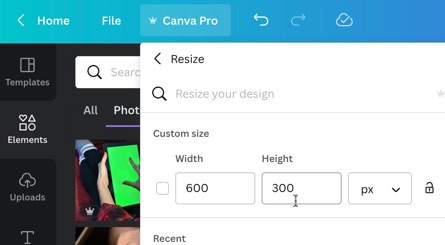
All of this helps your SEO in one way or another.
Here are some examples of image adaptations from the featured image for a post on how to add Google Search to your website: 
9. For Maximum SEO, Be Consistent
We all know that for successful blogging, consistency is key, particularly when it comes to SEO.
The same applies when repurposing content for different platforms.
You’ve got to keep showing up.
Unfortunately, a lot of the advice out there on repurposing seems to promote the idea of “Random Acts of Repurposing”, which essentially boils down to:
If a blog post happens to do particularly well, then repurpose it elsewhere.
Otherwise, don’t bother.
Really?
There are a couple of main problems with this approach:
- There’s no guarantee that just because a post did well on your blog that it would do likewise when repurposed elsewhere. A sub-performing post on your blog could become a successful outlier when repurposed onto another platform. Why ignore that possibility?
- The content consumer doesn’t know that what they’re looking at is repurposed. For them, it’s fresh and new. But for them to join your audience, they don’t want sporadic, every-now-and-again content. They want consistency. They want to know you’re committed to that platform. That’s the only way you:
- Build relationships
- Increase results over time
- Grow long-term SEO benefits.

Instead, effective repurposing, including for SEO, demands consistency. That means repurposing for relevant content platforms on a regular basis.
This can get cumbersome, but with Trafficonomy's content marketing workflow software, you can streamline everything including:
- Automatically delegating the relevant tasks
- Ensuring everything runs like clockwork.
Realistically, it's the only way to ensure you achieve the required levels of consistency, enabling you to:
- Grow your audiences on multiple platforms
- Build authority that translates into long-term and significant SEO benefits
The truth is, the “Random Acts of Repurposing” approach simply doesn’t cut it.
For successful blogging, consistency is key. The same applies when repurposing that content. By repurposing consistently, you build audiences, authority and long-term SEO advantages.Click To Post On10. Repurpose to Attract Leads (Indirectly Helping SEO)
As already mentioned, leads on your list help build SEO indirectly through the relationship they have with you.
- When leads on your list connect with you on social, engage with your posts, and share your content with their own audiences, that all helps build positive social signals for SEO
- Their relationship and growing familiarity with you means that, when searching for relevant keywords, they’re more likely to click through on your content in the SERPs—more positive signals for SEO
- Some may link to your content from their own, providing backlink benefits
So it figures that by repurposing content in ways that attract more leads onto your list you’re also helping your SEO.
This can include repurposing it into a lead magnet, such as a downloadable PDF, and then offering it via your blog as well as other channels you've repurposed content to.
Rather than leave leads on the table, use Trafficonomy to ensure someone takes care of this each time you post.
11. Update Blog Posts Regularly
Another way to repurpose blog posts while benefiting your SEO is to update them on a regular basis.
This keeps your content fresh and, combined with the fact that the content likely has some longevity (in contrast with a yet-to-be-indexed brand new post), often provides a rapid ranking boost.
After all, it's in Google's interests to push the freshest, most authoritative, most relevant content to the top of the SERPs, because that's what their users want.
Best practice is to:
- Schedule to revisit each blog post once a year
- Update and freshen up the content, thereby providing a boost to its ranking and the traffic it attracts.
Do this like clockwork, and the impact becomes significant.
Use Trafficonomy to schedule it, delegating the task automatically along with a required time frame.
This ensures it gets taken care of rather than just forgotten about.
12. Repurpose Content as FAQs
Finally, there are likely to be a few, even several, of your posts, videos, or podcast episodes that answer questions that you get asked frequently by prospects and customers.
So why not repurpose such content as answers to FAQs within a separate section of your website?
Doing so:
- Attracts additional search engine traffic by reusing that content
- Boosts the SEO of the original content if you link to it for further reference
- Keeps visitors on your site for longer, another positive SEO signal
Simply, paraphrase or summarize the relevant content as an answer to an FAQ.
Where suitable, you can also provide a link to the original more in-depth content, giving visitors additional information on the topic if required, and further building your authority and relationship with them.
Frequently Asked Questions
How can repurposing content onto different platforms help SEO?
By repurposing content on multiple platforms, you increase search visibility and attract new audiences, leading to higher rankings and more traffic.
Why shouldn't you copy-and-paste blog content verbatim onto other platforms for SEO?
Copying verbatim can harm your rankings, so modify the content to create unique versions for better SEO results.
What is the benefit of embedding YouTube videos back into blog posts for SEO?
Embedding videos adds value, enhances visitor experience, and increases the time visitors spend on your site, all factors that can boost rankings and search engine traffic.
How does repurposing video or podcast content as blog posts benefit SEO?
Repurposing video or podcast content into blog posts enhances visibility on search engines, increases video views/subscribers, and contributes to SEO through diverse content formats.
Why is consistency important when repurposing content for SEO?
Consistent repurposing across platforms builds audiences, authority, and long-term SEO benefits, ensuring you stay visible and engaged with your target audience.
To Conclude
So that’s 12 tips on effectively repurposing content for SEO, helping you:
- Grow your visibility on search (as well as content platforms like YouTube)
- Increase your traffic from Google and other search engines.
